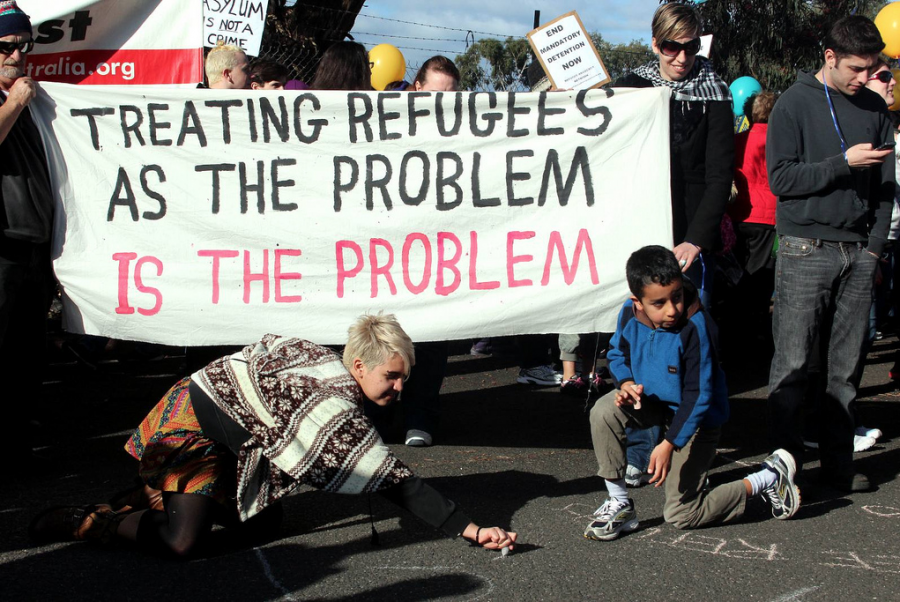Wally Hill on Trump’s immigration plan
Takver / Flickr.com
This sign is one of many held up in support of refugees at marches around the country. Trump has proposed a $21.6 billion border wall, stretching from the Gulf of Mexico to the Pacific Ocean to keep out refuges and immigrants.
February 16, 2018
From the man who campaigned on building a wall to stop illegal immigration comes the banning of refugees to prevent terrorism.
President Trump’s extreme stances on immigration generally display his lack of knowledge in foreign policy. Trump identifies Muslims, especially Muslim immigrants, as a threat to national security, citing both fake terrorist attacks, like the “Bowling Green Massacre”, and real ones that American Muslims who were radicalized in the U.S. committed. His travel ban – which he himself has called a “Muslim ban” – enforces major travel and immigration regulations on 11 Muslim-majority countries in Africa and the Middle East.
Although much of Trump’s travel ban remains intact, he recently lifted the temporary ban on refugees from 11 “high risk countries” under the pretense of protecting national security. The Department of Homeland Security has since tightened regulations on refugee admission. In fact, Trump has slashed maximum refugee admission from President Obama’s 110,000 to 45,000. Despite the Trump administration’s “evidence based” policies against terrorism, refugees are the last people to be terrorists. Refugees are people fleeing persecution, war, natural disasters, and terrorist attacks; they are not the ones committing them.
Over the past three years, 40 percent of U.S. refugees have come from these 11
“high risk” countries, so it is important to know the conditions that force refugees in Syria, North Korea, Mali, Libya, Iran, Iraq, Sudan, South Sudan, Egypt, Somalia and Yemen to leave.
Most refugees or displaced persons live in overcrowded camps without enough food, water or medicine. Rates of disease, sexual violence, child soldier recruitment and child marriage often soar while access to education and public services decline. Rebel groups or government forces in countries embroiled in civil war arbitrarily detain and torture journalists and activists and sabotage access to humanitarian aid.
Armed conflicts generate massive numbers of refugees. South Sudan enters its fifth year of civil war in 2018, where over two million people have already been displaced. Fighting in Iraq against ISIS has displaced at least three million people. An ongoing civil war in Yemen exacerbates what is already the one of the world’s largest humanitarian crisis, with three million on the brink of famine, and up to one million civilians infected by a cholera epidemic.
ISIS has committed the most serious crimes against humanity in Iraq, Syria and Libya. Both the Syrian government, with support from Russia and Iran, and terrorist groups like ISIS indiscriminately and deliberately attack civilians. According to Human Rights Watch’s World Report, U.S.-led coalition airstrikes against ISIS may have killed thousands of civilians, yet the U.S. fails to take accountability or conduct thorough investigations into these possible deaths.
The people who survive these trying circumstances are the people Trump’s refugee ban stops from entering the country. They, who have lost everything, wait in limbo, while a ban arbitrarily demands they wait yet again, while their lives are threatened every day.
Trump serves as Commander in Chief without a fundamental understanding of foreign policy. He has yet to coherently explain his plan for security on the U.S.-Mexico border, but he still wants to build a wall there. So how can Trump justify intensifying airstrikes and barring refugees abroad?
Whether Donald Trump is racist or ignorant, there is no excuse for drastically reducing support for refugees. Regardless of his intentions, the president is complicit in the suffering of millions worldwide.
All views shared in the Opinions section of The Chatterbox belong to their respective authors, and may not represent the views of the publication as a whole..




![Freshman choir students practice in class. “[The class] is almost like an army working together,” Anthony Nims, choir director, said.](https://whhscbox.com/wp-content/uploads/2025/10/freshman-choir.png)
![New theater teacher Mr. Mitchell leads his Stagecraft students through hands-on set-building techniques. “For me, [teaching] comes from the joy of learning, which is why I wanted to be in an educational setting.”](https://whhscbox.com/wp-content/uploads/2025/10/IMG_3248-901x1200.jpeg)

